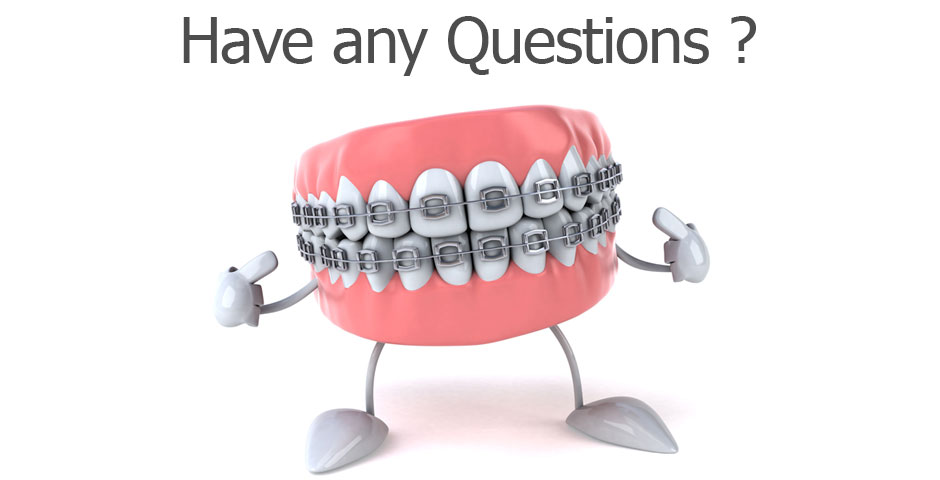During our consultation with patients who need braces, we have discovered many doubts and myths, which patients have about braces. The below post will highlight important questions and its answers, with the purpose of equipping you with improved and precise sknowledge about braces.

What is the right age for children to visit an Orthodontist?
At the age of 7 or 9 years, when all permanent teeth have evolved, parents must consult an Orthodontist for proper evaluation and growth of the jaw structure, and for an orthodontic treatment, if needed. At this age, it is easier to correct any orthodontic flaw within a short time period as compared to adulthood.
What are the symptoms that indicate the need of braces?
- Gaps between the teeth
- Over bite, under bite, cross bite, multiple crocked teeth
- Mis-aligned teeth
- Overlapping teeth
Is it necessary to consult an Orthodontist only?
Special care or treatment needs to be adopted as per the condition of the patient. Sometimes, general dentists aren’t aware of or haven’t utilized the latest solution and methods available for a short and painless treatment. Orthodontists are expert in diagnosis of teeth position, and the types of braces you require. According to your need, they suggest a treatment which improves your facial appearance, in the minimum possible time frame.
For first diagnosis, you may consult your family dentist, but for precise treatment, we recommend the precise care of a seasoned Orthodontist..
What are the alternatives for metal braces and which kind of braces is best for me?
- Ceramic braces
- Invisalign or clear braces
- Lingual braces
Above three are widely used alternatives of metal braces, as they are less visible. Selection of a specific brace, solely depends on your condition. Each has its own pros and cons, but your dentist evaluates your needs to suggest the best pair of braces.
How long I will need to wear braces?
Depending on your condition, the treatment can last from 6 to 18 months, and may even last longer in some cases. As per the brace type, the time of the treatment also varies.
Metal braces are highly effective and require lesser time as compared to other braces. On the other hand, Invisalign requires more time, as they are removable, one needs to wear it for 20-22 hours in a day.
How many appointments are required for braces installation?
Generally, under normal conditions, brace installation can be accomplished in 2 to 3 appointments.
Basic diagnosis and analysis is done in the first appointment, while installation is done at the second appointment. During the first appointment, your dentist will explain your condition, the solution, and the cost.
Before applying braces, your dentist may adopt teeth cleaning, or a tooth extraction, the worst case scenario, which may demand an extra appointment.
If you opt for Invisalign, you need to get a custom-made plastic aligner. Subsequently, the time between first appointment and final set up may delay.
Special care after having braces?
- You need to take extra care for cleaning your teeth and must ensure that any food particle does not remain in between the teeth or the corner of the brackets. Brushing and flossing twice will solve the issue.
- You need to avoid hard foods and sugary drinks. Sugary food invites bacteria that may lead to tooth decay, now who wants a tooth decay?
- If possible, you also need to schedule a visit with your family dentist to ensure good oral hygiene with braces.
- You also need to take care that your braces aren’t hit directly with hard surface which may break the braces, band the wire and impact the placement of bonding.
What if braces make me uncomfortable chewing or speaking?
In the first few days, feeling of discomfort is quite normal, but you will get used to braces with time.. In certain cases, due to an inappropriate bonding or due to the position of the brackets, discomfort grows, which requires immediate consultation with your dentist for a check- up. In case of lingual braces, which fit underneath the teeth, at the back side, you have to control the movement of the tongue or continuous touch with wire can cause more discomfort or harm.
Should I go for dental implants or braces in case of a missing tooth?
A dental implant is placed in the jaw bone and can’t be shifted or moved. Due to a missing tooth or a gap, the surrounding teeth may start to move from their position and don’t leave enough space for the implant. In this circumstance, it is necessary to first take a treatment prescribed by your orthodontist, in order to move the teeth to its proper place, and then perform the dental implant.
If orthodontic treatment needs to be applied only on the frontal teeth, then performing a dental implant seems to be fine on the rear side of the jaw. In most cases, a dentist recommends braces initially, followed by an implant.
What about a cracked tooth and a tooth subjected to root canal treatment?
Cracked tooth must be covered with a dental crown for its further protection. If you have replaced the crown recently, you must inform your dentist about it, before he/she places brackets on your teeth. As it is just a crown, it will move just like natural teeth and won’t cause any trouble.
If your tooth with root canal isn’t covered with a cap, after diagnosis, your dentist may suggest an artificial crown, for protection of that tooth.
It is always good to discuss past dental history and treatments, during your appointment with an orthodontist.
What is the cost of the treatment?
Normally, the cost depends on factors like, complexity, methods, estimated time of treatments and types of braces require. So, the cost of orthodontic treatments varies from one patient to another.
Should I need to wear a retainer?
After completing the treatment, for a few months, it is recommended wearing a retainer, but it isn’t necessary to wear it unless any of your teeth is broken and creates an extra gap.
Have we missed anything? Why don’t you ask directly to our Orthodontist at Monash Dental Group? Let us know your doubts or enquiries and our proficient dentists will resolve them with tailo-made solutions.



